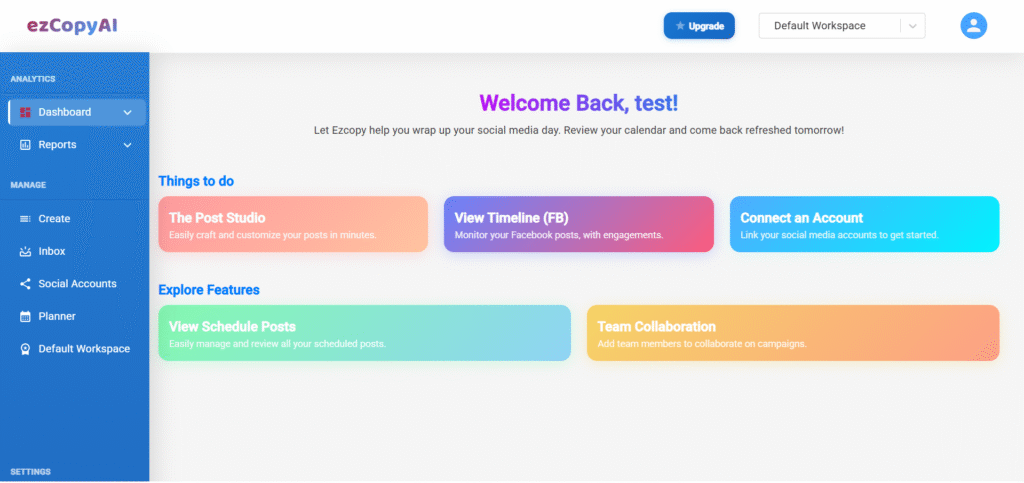
Learn how to build a powerful social media content plan that grows your brand, engages your audience, and drives real business results.
The content you share on social media has the power to transform your brand from just another name online into a trusted, recognizable favorite. With the right approach, casual followers can turn into loyal fans — but that only happens when you have a well-structured social media content strategy.
To make an impact, you need to:
- Define clear goals
- Craft content that delivers real value
- Share it on the platforms where it resonates most with your audience
There’s no one-size-fits-all formula for social media success. Your strategy should be shaped by your industry, target audience, and the insights you gain over time.
Still, there are proven methods to build a sustainable plan that strengthens your brand presence and drives business growth.
Try ezCopy for Effortless Social Media Content Creation
ezCopy helps you plan, create, and repurpose high-quality posts in minutes — whether it’s captions, visuals, or ad copy — while keeping your brand’s voice consistent. Perfect for busy marketers who want results without spending hours drafting content.

Explore ezCopy and start creating smarter, faster.
In this post, we’ll walk you through how to develop a winning social media content strategy from the ground up.
9 Steps to Build a Social Media Content Strategy That Actually Works
A strong social media content strategy isn’t just about posting consistently — it’s about posting with purpose. From setting clear goals to analyzing results, here’s how you can craft a content plan that grows your brand, keeps your audience engaged, and drives measurable business outcomes.
- Define Clear Goals
Every effective social media strategy starts with well-defined goals. Knowing exactly what you want to achieve will guide the type of content you create and where you share it.
Begin by connecting your social goals with your overall marketing objectives. Are you looking to increase brand awareness, drive traffic to your website, or convert more sales? The clearer your goals, the easier it will be to plan posts that move followers through your marketing funnel.
For instance, if your main goal is sales, focus on posts that encourage clicks to landing pages, product pages, or promotional offers.
- Understand Your Audience
You can’t create content that resonates if you don’t know who you’re speaking to. Develop buyer personas — detailed profiles of your ideal customers — to better understand their interests, demographics, and online behaviors.
Use your social analytics to gather demographic data such as age, location, and activity patterns. Then, dig deeper with social listening tools to discover how people talk about your brand or industry. This will help you tailor content that feels personal and relevant to your audience.
- Research Your Competitors
Your competitors can teach you a lot about what works — and what doesn’t. Conduct a competitive analysis by studying their profiles:
- Which platforms are they most active on?
- What type of content do they post (videos, carousels, polls)?
- How does their audience engage with them?
Use competitor analysis tools to track engagement rates, audience growth, and top-performing posts. This data will help you set benchmarks and inspire fresh content ideas.
- Audit Your Existing Content
Before planning new content, take stock of what you’ve already posted. A content audit will help you identify which posts perform best, which underperform, and why.
Review your analytics for key metrics such as impressions, reach, and engagement. Compare your assumptions with real data — sometimes posts you didn’t expect to perform well will surprise you. Look for trends in format, tone, and timing.
Pay attention to platform-specific performance. If certain networks consistently outperform others, allocate more resources there rather than spreading yourself too thin.
- Create a Data-Driven Content Plan
Now that you understand your goals, audience, and existing performance, it’s time to build your content plan. Think creatively but let your data guide your decisions.
Mix up your content types to keep things fresh. Try:
- Educational or “edutainment” videos
- Behind-the-scenes or employee spotlight posts
- User-generated content (UGC)
- Contests, polls, or live Q&A sessions
- Collaborations with creators or influencers
Authenticity is key. Audiences today want transparency, personality, and real value — not just promotions.
- Organize with a Content Calendar
A social media calendar helps you visualize, schedule, and manage your posts across platforms. It also keeps your team aligned and ensures a consistent posting rhythm.
Plan your content around the best posting times for each platform, based on your analytics. Don’t be afraid to repurpose high-performing content across different networks to get the most out of it.
Collaborative calendars are especially useful for teams, allowing multiple people to contribute ideas, approve posts, and track progress.
- Collaborate with Influencers
Influencer partnerships can fill content gaps and expand your reach. The key is aligning influencer-created content with your brand’s overall strategy.
If your team lacks resources for short-form video production, consider collaborating with influencers who excel in this format. Plan ahead so their content fits naturally into your posting schedule.
- Promote and Distribute Strategically
Don’t just post and hope for the best — actively distribute your content for maximum visibility.
- Schedule posts in advance to hit peak activity times.
- Encourage shares and engagement by asking questions or prompting discussions.
- Leverage employee advocacy — team members sharing posts can dramatically extend your reach.
- Use platform-specific features like hashtags, groups, and stories to boost discoverability.
- Track Performance and Optimize
The final step is measuring results. Regularly reviewing your analytics will show you what’s working and where to improve.
Key metrics to track include:
- Awareness: Impressions and reach
- Engagement: Likes, comments, shares, and clicks
- Conversions/ROI: Website referrals, sign-ups, or sales
Use this data to test new content formats (A/B testing works great) and refine your strategy over time.
By following these nine steps, you’ll create a social media content strategy that’s not only consistent but also effective in driving engagement and business growth.
